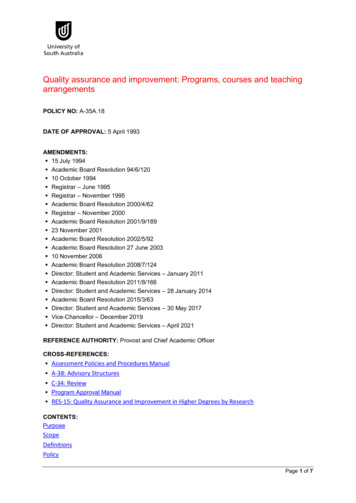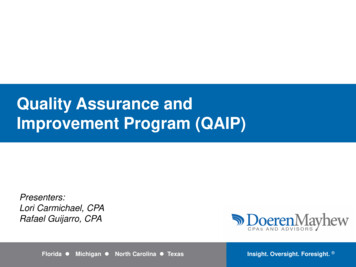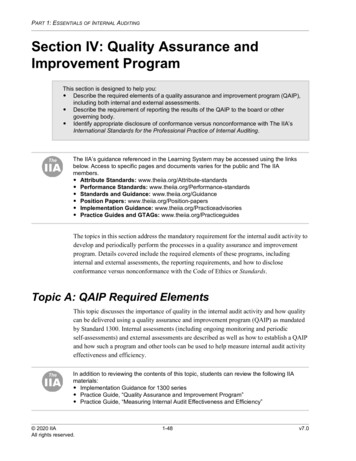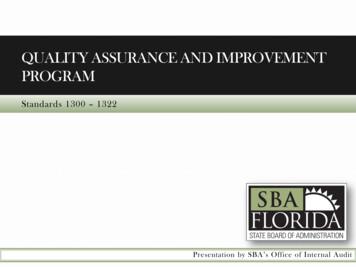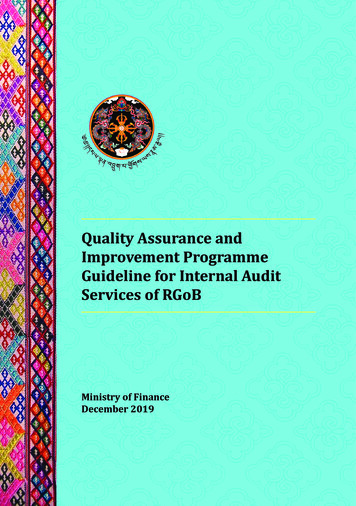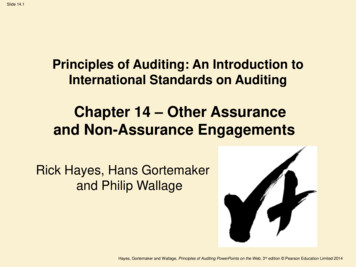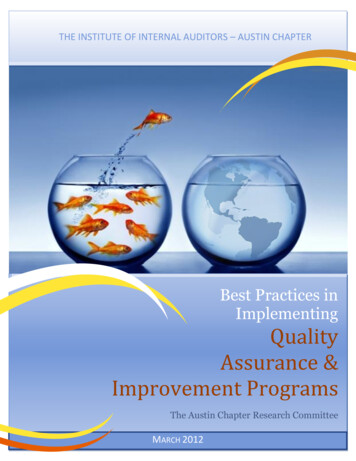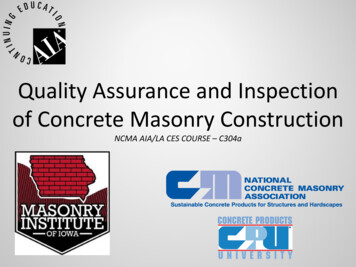
Transcription
Quality Assurance and Quality Improvement PlanI.PurposeThe Quality Assurance and Improvement Plan (QA/QI Plan) is a guide designed to assess, enhance,measure, and improve the quality of services, programs, and agency operations within the availableresources and achievable goals of Community Services for Every1. The Agency believes that a strongcommitment to Quality Assurance and Quality Improvement helps us achieve our vision to strive forexcellence by supporting partnerships, creating solutions and fulfilling the dreams of the people weprovide services to in the Western New York community. Community Services also believes thatcommitting to continuous quality improvement will allow us to provide highest quality services topeople who need them for the best value for the funders who pay for those services. The plan providesthe mechanism to measure and manage information between programs and people receiving services,to monitor agency wide progress, and resolve identifiable problems and to improve services. It isintended to be an ongoing process that will evolve and change in conjunction with the needs of theprograms and people receiving services. Implementation of the plan will assist the agency inmonitoring and improving services, operations, and accountability.The Plan also evaluates Basic Assurances under the agency CQL Quality Assurance Accreditation.The Basic Assurances look at the provision of safety measures put into action from the person’sperspective. The Basic Assurances require policies and procedures, or 'systems,' while theeffectiveness of the system is determined person by person. These assurances are not statements ofintent; rather, they are the essential, fundamental and non-negotiable requirements.II.Goal of the Quality Assurance and Improvement PlanQuality Assurance is defined as:"A systematic pattern of actions that is constantly optimizing servicedelivery, productivity, communication, and value within the agency. It includes activities intended toassure or improve the quality of services and agency operations. The concept includes the assessmentor evaluation of the quality of care or work performance and the identification of problems orshortcomings.Quality Improvement is defined as: “Activities designed to overcome identified deficiencies, improveservices or agency operations, and follow-up monitoring to ensure effectiveness of corrective steps.”The goal of the QA/QI Plan is to identify, document, and correct known or suspected deficiencies foundin service delivery or other areas of agency operations, and continue to measure, monitor and improveoutcomes. In addition, the plan will serve as a mechanism for communicating exceptional servicedelivery and best practices related to The Basic Assurances . Through the QA/QI Plan, programs andservices will be monitored throughout agency to ensure that people receiving services receive thehighest quality of services in a healthy and safe environment. In addition, the plan will serve as aguide on how to address other identified areas in the agency in need of improvement.III.ObjectivesThe following objectives are the focus of the QA/QI Plan: Develop and implement ongoing monitoring systems and auditing tools for identifying strengths,problems or opportunities to improve services.Rev. 11/191
IV.Establish a framework that demonstrates accountability for quality services and operations to theBoard of Directors and Executive Leadership.Provide a structure for agency-wide measurement and improvement of performance indicators,including service delivery, program outcomes, Basic Assurances , and compliance. The indicatorswill:- Relate to the mission, vision and values of Community Services.- Describe achievement of program and organizational goals.- Identify opportunities for improvement of outcomes.- Facilitate the evaluation of similar processes within CommunityServices.Determine the origin and extent of identified problems. Set precedence for the resolution ofidentified problems such as developing Focus Groups, policies and procedures, recommendingequipment, staffing changes, staff training, environmental improvements or facility changes, etc.Facilitate the improvement of the record review processes and procedures throughout the agencyby providing ongoing education and training of staff in agency-wide quality.Assure that the services provided by Community Services meet the standards of certification andother professional/regulatory requirements.Assure that compliance standards as outlined in the agency Corporate Compliance Plan areadhered to.Instruct, communicate, and support the concept of quality improvement in all facets of business,in order to integrate the real work with the management of quality.ResponsibilitiesThe Director of Quality Management is responsible for implementing and coordinating the plan toensure that the necessary staff is aware of identified problems and solutions, and to preventduplication of efforts.All Community Services programs and staff are responsible for establishing and maintaining a workingrelationship that is committed to improving and protecting the quality of services and agencyoperations. Whether the relationship to the person receiving services is direct or indirect, theoperational procedures of each department ultimately affect the quality of services that are provided.The senior leadership of Community Services and the Board of Directors members ensure that allAgency staff protect the people who are receiving services and maintain a strong commitment toquality. This commitment is monitored through board subcommittees, cross functional work groupsmade up of all levels of Agency staff and reports reviewed by senior leadership on a regular basis.V.Person Centered ServicesCommunity Services for Every1 strives to provide person centered services. We recognize thatindividuals need the information, skills, opportunities, and supports to live free of abuse, neglect,financial and sexual exploitation, violations of their human and legal rights, and the inappropriate useof restraints or seclusion. Quality assurance systems contribute to and protect self-determination,independence, productivity, integration and inclusion in all facets of community life. The followingservice delivery systems will assist the agency in achieving quality organizational results:A. Person Centered Planning - Involves establishing a partnership with an individual and his orher family to create a compelling image of a desirable future and inviting participation to achievethose goals (Butterworth et al., 1997).Elements of Person Centered Planning are as follows: The empowerment of the individual. The use of natural support. A changing role for professionals in service planning. The use of a facilitator. An opportunity for redefining the person for all participants. A clear, unrestricted vision of the future. An opportunity for creative brainstorming.B. Support Model - Is grounded in the philosophy of normalization and involves manyproviders/disciplines working as a team, analyzing a variety of assessments, observations andinteractions with the Individual. The level of support is based on the strengths and limitations ofRev. 11/192
the person and his or her environment. It requires efforts that can help individuals be supportedby their communities and have opportunities to contribute to their communities. The supportmodel requires that individuals and the people providing direct supports be empowered.C. Personal Outcome Measures - A method of exploration to identify people's quality of lifeoutcomes, plan supports and information about individual outcomes. It is a discussion between aperson who receives our services and a POMs Interviewer to determine how well CommunityServices for Every1 is supporting the person in achieving those outcomes. Personal Outcomesare important because they place listening and learning from the person as the center of theagency, ultimately fulfilling our mission. Not all outcomes will be present for each person, andsupports may not always be there either. The goal is to learn and grow through this process andbuild in supports as needed.VI.The Fundamentals of ImprovementA. Setting AimsImprovement requires setting aims. An organization will not improve without a clear and firmintension to do so. The aim should be expressed in specific terms. For example, reduce thenumber of Serious Reportable Incidents by 15% or improve the satisfaction rates regarding choiceby 10%.B. Establishing MeasuresQualitative measures need to be used to determine if a specific change actually leads to animprovement. For example, is the number of Serious Reportable Incidents decreasing? Issatisfaction regarding choices improving? Has staff retention improved?In addition, it is important to ensure that any changes designed to improve one part of the systemare not causing problems in another part of the system. For example, teams working together toimprove satisfaction regarding choice should also make sure that there hasn’t been an increase inpoor choices resulting in an unintended increase in incidents.C. Testing ChangesAll improvement requires making changes, but not all changes result in improvement. CommunityServices is dedicated to improving the quality of services, however it is essential to identify thosechanges that are most likely to result in improvement.The following items need to be considered when new services or processes are being developedor when present services and processes are being redesigned: The organization's mission and strategic plan. Individuals, community and agency needs. Information about performance and outcomes of processes.VII.ComponentsA. Methodology/FocusChange and process are usually found together because the change that is going to beimplemented will generally manifest itself in a series of processes that, taken together, serve asa type of methodology.Community Services for Every1 has adopted the “FOCUS-PDCA Model” as its methodology formeasuring organizational performance improvement activities.The FOCUS-PDCA Model was developed by W. Edward Deming and improving process. The Model’sname is an acronym that describes the basic components of the improvement process. The stepsinclude:F ind a process to improveO rganize an effort to work on improvementC larify current knowledge of the processRev. 11/193
U nderstand process variation and capabilityS elect a strategy for continued improvementPDCA is an acronym for Plan, Do, Check, Act. The PDCA cycle is a way of continuously checkingthe progress in each step of the FOCUS process.The Model has two parts:What arewe trying toaccomplish?1. Three fundamentalquestions, whichcan be addressed inany order.How will we knowthat a change isan improvement?What Changes can wemake that will resultin improvement?2.The Plan-Do-CheckACT (PDCA) Cycle totest and implementchanges in real worksettings.PlanActDoCheckRev. 11/194
B. ProcessTeams -The following teams have been identified as essential elements of the Quality Assuranceand Quality Improvement Plan.1. Quality Assurance and Quality Improvement Standing Committee - Thiscommittee will serve as an oversight body for all Quality Assurance and QualityImprovement activities that directly or indirectly affects people’s services. TheQuality Assurance and Quality Improvement Standing Committee is a crossfunctional group identified by the V.P. of Program Support & Development to directthe execution of the QA/QI Plan. Where appropriate, this committee may ask thatpeople receiving services participate. This committee will help evaluate and directagency performance that exhibits high quality services. The Quality Assurance andQuality Improvement Standing Committee concentrates on the agency's qualityactivities and communicates these actions through the V.P. of Program Support &Development to the Quality Assurance and Quality Improvement BoardCommittee. The following are responsibilities of the Standing Committee: Establishes expectations and priorities for agency performanceimprovement efforts.Bi-monthly the Director of Quality Management will send out the QAQI Reports to the QA QI Committee members for pre-reading.Bi-monthly programs will attend the QA QI Meeting prepared todiscuss the progress made on the QI Plans that they are currentlyworking on.Plan and direct a course of action to measure, review, and improve.Evaluate on an ongoing basis, activities related to Individualsatisfaction and measurement of program outcomes.Continue a quality improvement focus on agency initiatives includingneeded policies and procedures.Identifies priorities for Quality Improvement Teams through theongoing review of quality review data.Provides support and acknowledgment for performance improvementefforts.In addition, the Quality Assurance and Quality Improvement Standing Committeewill conduct ongoing assessment activities across departments makingcomparisons of similar programs utilizing the data collected through currentquality review systems. Further assessments of agency services and relatedprocesses will be conducted when one or more the following criteria have beenmet: When Community Services wishes to improve good performance.When staff identify processes in need of improvement.In response to negative events or patterns of negative events.In response to outstanding performance evaluations conductedinternally or by external review bodies. Outstanding performancemay be positive or negative.2. Quality Improvement Team – Quality Improvement Teams will be formed inresponse to the analysis of internal and external data. Priority for team efforts willbe directed toward services that are important to the people we serve. Teams willbe established when specific processes or areas of improvement are identified.The Quality Assurance and Quality Improvement Standing Committee will initiatethese teams. The V.P. of Program Support & Development is responsib
The Quality Assurance and Improvement Plan (QA/QI Plan) is a guide designed to assess, enhance, measure, and improve the quality of services, programs, and agency operations within the available resources and achievable goals of Community Services for Every1. The Agency believes that a strong commitment to Quality Assurance and Quality Improvement helps us achieve our vision to strive


